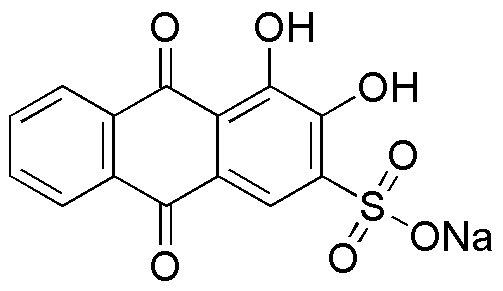Alizarin Red S sodium salt is widely utilized in research focused on:
- Histology and Microscopy: This compound is commonly used as a stain for calcium deposits in tissues, making it invaluable in histological studies. Researchers can easily visualize and quantify mineralization in biological samples.
- Analytical Chemistry: It serves as a chelating agent for metal ions, allowing for the detection and quantification of various metals in environmental samples. This application is crucial for monitoring pollution levels and ensuring compliance with environmental regulations.
- Textile Industry: Alizarin Red S sodium salt is used as a dye in textile applications, providing vibrant colors to fabrics. Its stability and affinity for fibers make it a preferred choice for dyeing processes.
- Biological Research: The compound is employed in studies related to bone and dental research, as it helps in tracking mineralization processes. This is particularly useful for understanding diseases like osteoporosis.
- Pharmaceuticals: It has potential applications in drug formulation, particularly in developing formulations that require specific pH levels for stability. This versatility can enhance the effectiveness of certain medications.
General Information
Properties
Safety and Regulations
Applications
Alizarin Red S sodium salt is widely utilized in research focused on:
- Histology and Microscopy: This compound is commonly used as a stain for calcium deposits in tissues, making it invaluable in histological studies. Researchers can easily visualize and quantify mineralization in biological samples.
- Analytical Chemistry: It serves as a chelating agent for metal ions, allowing for the detection and quantification of various metals in environmental samples. This application is crucial for monitoring pollution levels and ensuring compliance with environmental regulations.
- Textile Industry: Alizarin Red S sodium salt is used as a dye in textile applications, providing vibrant colors to fabrics. Its stability and affinity for fibers make it a preferred choice for dyeing processes.
- Biological Research: The compound is employed in studies related to bone and dental research, as it helps in tracking mineralization processes. This is particularly useful for understanding diseases like osteoporosis.
- Pharmaceuticals: It has potential applications in drug formulation, particularly in developing formulations that require specific pH levels for stability. This versatility can enhance the effectiveness of certain medications.
Documents
Safety Data Sheets (SDS)
The SDS provides comprehensive safety information on handling, storage, and disposal of the product.
Product Specification (PS)
The PS provides a comprehensive breakdown of the product’s properties, including chemical composition, physical state, purity, and storage requirements. It also details acceptable quality ranges and the product's intended applications.
Certificates of Analysis (COA)
Search for Certificates of Analysis (COA) by entering the products Lot Number. Lot and Batch Numbers can be found on a product’s label following the words ‘Lot’ or ‘Batch’.
Numéro de catalogue
Numéro de lot/série
Certificates Of Origin (COO)
This COO confirms the country where the product was manufactured, and also details the materials and components used in it and whether it is derived from natural, synthetic, or other specific sources. This certificate may be required for customs, trade, and regulatory compliance.
Numéro de catalogue
Numéro de lot/série
Safety Data Sheets (SDS)
The SDS provides comprehensive safety information on handling, storage, and disposal of the product.
DownloadProduct Specification (PS)
The PS provides a comprehensive breakdown of the product’s properties, including chemical composition, physical state, purity, and storage requirements. It also details acceptable quality ranges and the product's intended applications.
DownloadCertificates of Analysis (COA)
Search for Certificates of Analysis (COA) by entering the products Lot Number. Lot and Batch Numbers can be found on a product’s label following the words ‘Lot’ or ‘Batch’.
Numéro de catalogue
Numéro de lot/série
Certificates Of Origin (COO)
This COO confirms the country where the product was manufactured, and also details the materials and components used in it and whether it is derived from natural, synthetic, or other specific sources. This certificate may be required for customs, trade, and regulatory compliance.


